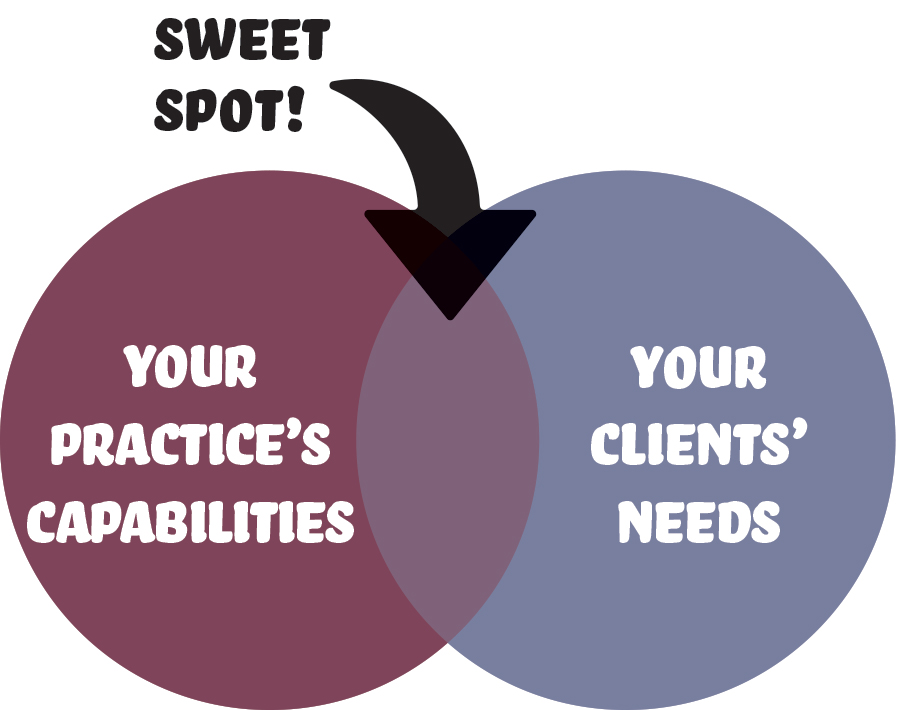

By Louise Dunn
uring the pandemic, it seemed as if everyone was suffering from the stress of too many appointment requests and not enough hours in the day to see all the patients. Fast forward to today, and your practice is still likely suffering from this same problem. Looking back, is it possible that appointment scheduling snafus were an issue before the pandemic, and the pandemic just exacerbated an existing problem that continues up to today?
Unfortunately, how you scheduled appointments may have already been on the verge of breaking years ago. An overbooked appointment schedule may be one symptom. To fix this, you need to look deeper into the root cause of your scheduling snags and what you can do about them.


To find out, you first need to dig a little. More specifically, you need to find out where your practice’s capabilities match client needs in a way your competition can’t.1 And this starts with identifying three key elements: your competition, your clients’ needs, and your capabilities. Achieving the sweet spot for optimal scheduling requires a strategic process that looks at all three elements.




Listen to what your clients are saying. Did they switch to your practice because their last veterinarian never had any openings? Do they talk about how easy it is to schedule with their dentist but scheduling an appointment for their pet takes twice as long and feels as if they have to jump through hoops to do it? In the big picture of competition, your competitor is anyone your client compares you to, so look beyond veterinary and monitor trends in other industries.

Asking, “How easy was it to schedule your pet’s appointment?” sounds simple enough, but let’s get a little more specific. You must explore the entire client journey—from requesting an appointment to checking out—because all those touchpoints factor into setting up your appointment schedule. You may want to select a specific group of clients, making sure it is diverse (e.g., age of clients and pets, services requested, time and doctor preferences, scheduling methods preferred, etc.).
Consider asking your clients for suggestions on technology use, automated processes or other customer service innovations they feel would be beneficial. Using technology can not only improve the client experience, but it can also improve how the practice allocates time and schedules the team.

Identify what capabilities you need to develop to overcome scheduling snags, best serve your clients’ needs and efficiently schedule the team.

Recall that the sweet spot is where your practice’s capabilities match your clients’ needs in a way your competition can’t. You looked at what competitors were doing, asked key clients about their needs and assessed your capabilities. Your next move depends on your findings, but here are some things your colleagues are doing to improve access to care and relieve appointment headaches:
- Holding huddles to review the schedule and map out a plan of action
- Reserving slots for same-day appointments
- Reserving times for walk-in appointments
- Forward booking appointments
- Setting up a 24/7 veterinary nurse advice line
- Conducting virtual exams
- Establishing Technician/Nurse appointments
- Using a transcriptionist in the exam room (e.g., a vet assistant or using a virtual transcriber)
- Creating an Admit Nurse position
- Creating a Floater DVM position to handle walk-ins, emergencies, work-ups, and care for hospitalized patients
- Repositioning what team members are responsible for so as to work at the top of their license more effectively (e.g., not having a veterinarian draw blood when a technician or assistant can do it)
- Conducting client education classes instead of using up exam room time (especially for puppy and kitten topics)
- Creating a Physician Assistant position utilizing veterinarians who graduated out of the country and have yet to be licensed in the U.S.
- Contracting with a semi-retired veterinarian to conduct virtual consults
- Streamlining paperwork by completing it electronically in advance of the appointment
- Changing exam room procedures to mitigate inefficiencies (e.g., the use of scribes or Fear Free techniques).
Some of these options address available time slots to mitigate overbooking, others expand access to care via other means of seeing a medical professional, some seek to reduce time spent in an exam room, and others utilize different positions to handle the workload. There is no one-and-done solution found on this list, but it demonstrates that your colleagues are thinking beyond only an overflowing appointment schedule.
Your action plan depends on your pain points because your practice is unique, as are the mix of patients you see, procedures you perform and treatment plans you recommend. Your choice also depends on where you want to develop your capabilities for future client and business needs. Don’t take the stance that “this too shall pass;” that your scheduling problem resulted from the COVID pandemic, and you will soon be back to your old ways.


The following are efficiency indicators to track each quarter:
- Team and DVM hours per transaction (should be 1.33-2.33 for best efficiency)
- Revenue / FTE DVM
- Invoices / FTE DVM
- Support-team wages as a percentage of revenue.
Start with the numbers from the past year and set goals for the next quarter. Implement a few changes to how appointments are scheduled and how the team is scheduled to see if it changes the numbers.
In addition to efficiency indicators, conduct a time study to track how much time is needed for your services. After all, there have been advances in technology and changes to your standard procedures over the years—did you ever evaluate how these changes affect time slots for different services? Then, look outside the box (the exam room box, that is) for ways to change how you deliver your services to patients.
For example, can the practice have a virtual team performing virtual visits which then opens up exam rooms for other visits? Can a tech/nurse conduct client education via a Zoom call (such as new puppy/kitten issue or dealing with an ongoing long-term condition), thus relieving the strain on the appointment book from unavailable exam rooms? It behooves you to consider future business performance by looking at what weaknesses were exposed, what responses you made (or didn’t make), and where the future of patient care and client experience is going.
What constitutes the best appointment schedule is evolving…as is what clients value and expect in their veterinary experience. The veterinarian continues to lead patient care, but now shares the responsibility with other team members. The client sees those other team members as extensions of their pet’s veterinarian and is comfortable working with a team of veterinary healthcare providers.
Reimagining how your practice sees patients and communicates with clients goes beyond time slots on a computer screen. It is about improving access to care and staying connected with clients. It involves taking into consideration the wellbeing of the team in addition to the patients. The goal is to achieve schedule efficiency (both staffing and patient scheduling) without sacrificing accessibility or quality of care. Take time to determine your scheduling sweet spot and improve how you provide care to your patients.
- Collins, D., Rukstad, M. (2008, April). “Can You Say What Your Strategy Is?” Harvard Business Review, page 89. https://idea-sandbox.com/blog/strategic-sweet-spot/


